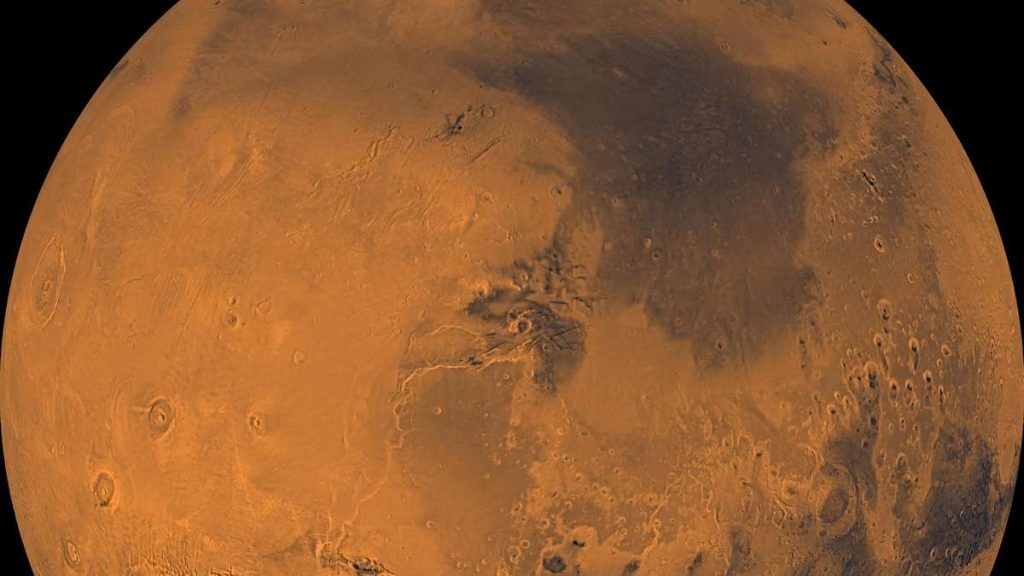Today, Mars has almost no atmosphere, and there is no longer any water on the surface.
©NASA/JPL/USGS
NASA’s Mars probe makes a startling discovery. This discovery arouses tremendous enthusiasm among researchers.
Frankfurt/Pasadena – Shortly after arriving on the planet Mars* In February 2021, NASA’s “Perseverance” rover sent researchers back to Earth data that clarified a key question about Mars: Was the Jezero crater where the rover once landed was a lake? The researchers’ answer was: Yes. “This is the main observation that definitively confirms that there was a lake and river delta in Jezero crater,” scientist Nicholas Mangold said in a NASA statement. The US space agency is now releasing the next surprise that the rover has discovered on Mars.
A few months after its landing on Mars, the “perseverant” rover once again answered a question that has long been in the minds of researchers: are the stones in the landing zone of sedimentary origin, that is, flowing water participates in its formation, or do they have volcanic origin in nature It was formed in lava flows?
“I started to despair and thought we would never find the answer,” she said. NASA* Perseverance Project scientist Ken Farley of the California Institute of Technology in Pasadena. “But then our PIXL instrument took a closer look at the rock pieces and everything turned out: the crystals inside are the indisputable evidence.”
NASA’s Mars rover: ‘perseverance’ clarifies the question that pushed researchers to despair
The investigation of the NASA research team, evaluating data from NASA’s latest rover: It is very likely that the underlying soil on which “Perseverance” has been standing and driving since landing on Mars was formed in super-hot red magma. Analyzing a rock, the Perseverance Vehicle PIXL instrument showed that the rock, which the researchers dubbed “brak,” consists of an unusual abundance of large olivine crystals encased in pyroxene crystals.
NASA’s future mission to transport Martian rocks to Earth
“A good student of geology will tell you that texture like this indicates rock formation when crystals slowly grew and settled in cold magma—for example, a dense lava flow, a lava lake, or a magma chamber,” Farley explains. After that, the stone was changed several times by water.
“It has become a treasure chest that will enable future researchers to date events at Jezero Crater,” Farley says. The researcher also suspects that this will help to better understand a time when water was not uncommon on the surface of Jezero crater and reveal the early history of Mars. It remains unclear whether the studied rocks cooled in a lava lake at the surface or in an underground chamber that later surfaced through erosion.
What happens in the sky, in astronomyAnd space travel and the space exploration? Subscribe to HNA’s free newsletter to stay informed.
The Mars rover has packed a piece of rock into a container to bring it back to Earth for a future mission. Then scientists on Earth could use instruments that are too big to travel to Mars in their research. NASA’s rover is set to fill a total of 43 small containers with soil samples from Mars, six of which have already been filled and sealed. It contains, among other things, the Martian material for which the rover was dug, as well as a sample of the Martian atmosphere.
NASA: Mars rover “Perseverance” discovered organic compounds
Another instrument of the “Persevering” Mars rover also provided the search on Earth with new data: Sherlock discovered organic compounds. In a statement, NASA said this does not automatically mean that life existed on Jezero Crater. There are biological and non-biological mechanisms by which organic compounds are formed and NASA’s Curiosity spacecraft also discovered organic materials at its landing site in Gale Crater*.
NASA’s Perseverance rover in the South Sittah area of Jezero Crater on Mars. There the rover analyzed the rock, showing researchers on Earth how it formed. The image was taken by NASA’s Mars Reconnaissance Orbiter.
©NASA/JPL-Caltech/University of Arizona
“What Sherlock adds to the story is the ability to map the spatial distribution of organic matter in the rocks and relate that to the minerals that are there,” explains Sherlock researcher Luther Beagle of NASA’s Jet Propulsion Laboratory. In this way, researchers can better understand the environment in which the organic compounds were formed.
The fact that organic compounds were found in the stones in the Jezero and Gale craters means that potential biosignatures – that is, signs of past or present life – have also been preserved. “It’s a question that probably won’t be resolved until samples are brought back to Earth, but preserving organic compounds is very exciting,” Beagle said. “When these Martian samples reach Earth, they will be a source of scientific research for many years to come.” (Tab) * fr.de view from IPPEN.MEDIA.

“Social media evangelist. Baconaholic. Devoted reader. Twitter scholar. Avid coffee trailblazer.”








More Stories
Longest jets in the universe discovered – giant particle streams as long as 140 Milky Way galaxies in a row
New method reveals 307 supernova remnants
Snapchat is upping the ante on augmented reality glasses